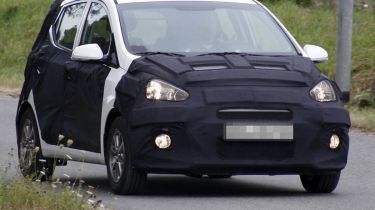New Hyundai i10 pricing announced
The new Hyundai i10 starts at £8,345, on sale in January 2014. It gets a bigger boot than a VW up! and sub-100g/km CO2 emissions
Prices for the new Hyundai i10 have been revealed - a car that Hyundai describes as a supermini in a city car package. Prices start from £8,345 and rise to £10,495.
The no-frills i10 five-door has been a fixture on Britain’s roads ever since it became the most popular car bought on the Scrappage Scheme three years ago. An amazing 110,000 have been shifted since it was launched in 2008, making it Hyundai’s best-selling model in the UK.
Existing owners might be shocked to learn a the new grown-up i10 - which cost from £4,995 with the £2,000 Scrappage discount - will start from £8,345 when it goes on sale on January. The price remains the same as the outgoing mode and Hyundai claims the new i10 boasts increased space, quality and more equipment.
• Hyundai i10 prototype review
Two petrol engines will be available from launch, which include a 65bhp 1.0-litre three cylinder motor and a more powerful 85bhp 1.2-litre petrol engine. The latter is expected to make up approximately 40 per cent of sales. The same engines can also be found in the Kia Picanto, with which the i10 shares its platform.
Trim levels are made up of S, SE and Premium and include standard equipment such as, central locking, electric front windows, USB input, daytime running lights, adjustable steering wheel and six airbags. Mid-range SE models receive additional, remote central locking, electric rear windows, electric heated door mirrors, body colour door handles and mirrors. Models in SE trim are priced from £9,292 and rise to £10,495 if you opt for the automatic gearbox.
Range-topping Premium trim adds 14 inch alloys, Bluetooth connectivity with voice recognition, steering wheel controls. All models come with five seats, apart from the SE Blue Drive variant which is only available with four but does boast sub 100g/km CO2 emmsions at only 98g/km.
Hyundai is promising a more dynamic drive, and will be hoping this – along with the step up in quality and practicality – will help the i10 improve on its Driver Power rating. The current model was the worst-performing Hyundai in Auto Express’ latest owner satisfaction survey, finishing a lowly 135th.
When we tested the prototype we were certainly impressed by the extra space on offer, considering the new grown-up i10 dimensions are just 80mm longer and 65mm wider than the old car. Hyundai claims the boot space is the largest in class, at 252 litres – one litre more than in a Volkswagen up! and 27 litres more than in the outgoing i10.
The rear is so roomy that a six-foot passenger can comfortably sit behind a six-foot driver, which should be more than adequate for the target market of families wanting a second car. They’ll also be impressed by the array of cubbies and bottle holders, plus the dashboard's soft-touch plastics and well engineered controls.
Hyundai product marketing chief Christian Loeer told us: “We found most customers preferred this type of craftsmanship to the bare-metal surfaces of the up!.”
Schreyer set to breathe new life into Hyundai
Peter Schreyer has overseen the design revolution at Kia, but since January his role has morphed into head of design for both Kia and Hyundai.
Although Schreyer probably didn’t influence the i10 heavily – it had already been all but signed off – the move heralds exciting times for Hyundai, and he is expected to reshape the firm’s cars in the same way he has Kia’s.
The i10 was styled at Hyundai’s German design centre. The boxiness of the old car was reduced by losing 50mm from the height, and flat surfaces broken up with the brand’s ‘fluidic sculpture’ 3D effect. Dark plastic inserts flank the tailgate to give the rear screen a wraparound effect.
Find a car with the experts



